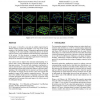Free Online Productivity Tools
i2Speak
i2Symbol
i2OCR
iTex2Img
iWeb2Print
iWeb2Shot
i2Type
iPdf2Split
iPdf2Merge
i2Bopomofo
i2Arabic
i2Style
i2Image
i2PDF
iLatex2Rtf
Sci2ools
VRML
2010
ACM
2010
ACM
Cognitive scaffolding in Web3D learning systems: a case study for form and structure
In this paper, we describe a case study in usability engineering for Web3D learning systems and introduce a new step to the typical methods of the usability design. Pedagogical applications present a challenge to the usual usability engineering process in that the end-users of the system (students) cannot describe the requirements of the system. For this situation, we engage the latest evidence and principles of cognition to help map requirements to information design for an interactive learning system. Our system seeks to improve the structural understanding of architects and to teach relationships between form and structure in long-span systems. We provide both explanatory multimedia resources and interactive resources including a Web-based modeling and simulation tool that aids architecture students with better understanding of the relationship between structure and form in design. We describe our design process and the system and examine the qualitative impact of the cognitive erg...
| Added | 16 Aug 2010 |
| Updated | 16 Aug 2010 |
| Type | Conference |
| Year | 2010 |
| Where | VRML |
| Authors | Felipe Bacim, Nicholas F. Polys, Jian Chen, Mehdi Setareh, Ji Li, Lee Ma |
Comments (0)

